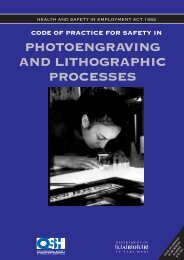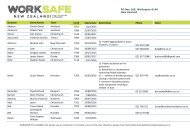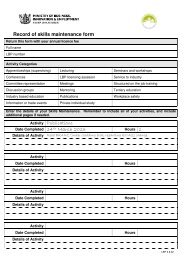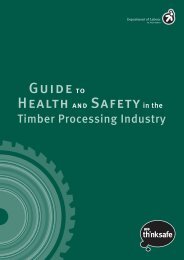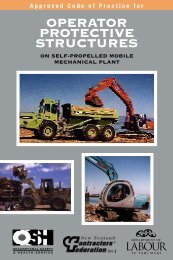(OOS) - Checklists for the Evaluation of Work - Business.govt.nz
(OOS) - Checklists for the Evaluation of Work - Business.govt.nz
(OOS) - Checklists for the Evaluation of Work - Business.govt.nz
You also want an ePaper? Increase the reach of your titles
YUMPU automatically turns print PDFs into web optimized ePapers that Google loves.
ACKNOWLEDGEMENTSDavid Brown, occupational health consultant,Sydney.Health and Safety Executive. Guide to <strong>the</strong>Prevention <strong>of</strong> <strong>Work</strong>-Related Upper LimbDisorders. London, 1990.Health and Safety Commission. Draft Code <strong>of</strong>Practice on Manual Handling (OccupationalOveruse Syndrome). Melbourne, 1990.Lindqvist B. (Ed). Ergonomic Tools in Our Time.Atlas-Copco, Stockholm, 1986.Putz-Anderson V. Cumulative Trauma Disorders:A Manual <strong>for</strong> Musculoskeletal Disorders <strong>of</strong> <strong>the</strong>Upper Limb. Taylor and Francis, London, 1988.ICL Ltd. (with Nottingham University).Ergonomics and <strong>the</strong> Electronic RetailEnvironment. London, 1987.Grandjean E. Fitting <strong>the</strong> Task to <strong>the</strong> Man. Taylorand Francis, London, 1986.Page 4
CHECKLIST 1:POLICYDEVELOPMENTA INCLUSION OF ERGONOMIC CRITERIAIN THE DESIGN OF EQUIPMENT ANDWORK* Are ergonomic criteria included in planningnew jobs?* Are ergonomic criteria included in equipmentspecifications?* Are staff accountable <strong>for</strong> <strong>the</strong> above?* Is finance available <strong>for</strong> actions and changesrequired?* Is <strong>the</strong>re a mechanism <strong>for</strong> implementing <strong>the</strong>recommendations stemming from checklist 2A?B STAFF TRAINING* Is <strong>the</strong>re a mechanism to deliver training:- about <strong>OOS</strong>- <strong>for</strong> task skills? (1)C PROVISION FOR CHANGES INWORKLOAD* Is <strong>the</strong>re provision <strong>for</strong> sudden changes inworkload? (2)* Is <strong>the</strong>re a mechanism <strong>for</strong> dealing with seasonalvolumes <strong>of</strong> work?D EARLY REPORTING OF SYMPTOMS* Is <strong>the</strong>re a reporting system <strong>for</strong> people wi<strong>the</strong>arly symptoms <strong>of</strong> <strong>OOS</strong>? (3)* Is <strong>the</strong>re a mechanism <strong>for</strong> dealing with suchindividuals?* Is liaison arranged with a qualified medicalpractitioner in advance? (4)NOTES1 TRAINING IN <strong>OOS</strong> prevention andmanagement is required by all operators and bysupervisors, as set out in <strong>the</strong> Guideline.2 SUDDEN CHANGES in workload have <strong>of</strong>tenbeen enough to precipitate a condition. Sources<strong>of</strong> changes are a production speed-up, o<strong>the</strong>r staff<strong>of</strong>f sick, catching up after a breakdown, and so on.3 EARLY REPORTING is one <strong>of</strong> <strong>the</strong> keys topreventing <strong>OOS</strong>. Reporting systems shouldinclude a method <strong>for</strong> dealing with a person whodoes report.4 LIAISON with a medical practitioner is anexcellent idea, but only if he or she is experiencedin dealing with <strong>OOS</strong>. If people with symptoms canbe sent <strong>for</strong> assessment early on, it is probable thatproblems can be prevented from getting moreserious.5 REHABILITATION is a process to restore aperson with <strong>OOS</strong> to full function. Its successdepends on <strong>the</strong> active co-operation <strong>of</strong> allconcerned. A rehabilitation programme should bedrawn up in advance, and should indicate who isresponsible <strong>for</strong> <strong>the</strong> programme. Elements <strong>of</strong> <strong>the</strong>programme are:(a) Where medical assistance can be obtained;(b) Where needed, training <strong>for</strong> supervisors aswell as <strong>the</strong> affected employee may beobtained;(c) Provision <strong>for</strong> <strong>the</strong> assessment and alteration(where necessary) <strong>of</strong> workstations;(d) Provision <strong>for</strong> a gradual return to work (seebelow);(e) The arrangement <strong>of</strong> alternative duties, whereapplicable (and possible);(f)The arrangement <strong>of</strong> a partial return to workwhere appropriate. Liaison with externalagencies should be listed.6 AFTER an absence, people will require time towork up to full speed. This is especially true <strong>of</strong> <strong>the</strong>person who has had <strong>OOS</strong>. After an injury, anoperator’s muscles may feel completely recovered,but <strong>the</strong>y have also lost fitness. As with fitness <strong>for</strong>any activity, a gradual build-up to full activity isPage 5
E REHABILITATION PROGRAMMEDEFINED?* Has a rehabilitation programme been drawnup? (5)* Is <strong>the</strong>re a policy <strong>for</strong> <strong>the</strong> gradual reintroduction(acclimatisation) <strong>of</strong> new staff or those who havebeen absent? (6)F ALTERNATIVE DUTIES* Have alternate duties <strong>for</strong> those with <strong>OOS</strong> beenidentified in advance?G ORGANISATIONAL PRACTICES* Is work monitoring <strong>for</strong> discipline purposesavoided? (7)* Is <strong>the</strong> variability <strong>of</strong> people in <strong>the</strong>irper<strong>for</strong>mance recognised? (8)* Are staff consulted when changes are made?(9)NOTESrequired. An example <strong>of</strong> a suitable programme is:Day 1: Four sessions <strong>of</strong> 15 minutes.Operating style should be monitored during<strong>the</strong>se periods, and relaxation made anecessary condition. Every day <strong>for</strong> 2 weeks,<strong>the</strong> operator should be checked by <strong>the</strong>supervisor to see how he/she is faring.Day 2: Six sessions <strong>of</strong> 15 minutes. Operatingstyle should be monitored <strong>for</strong> at least half <strong>of</strong><strong>the</strong>se sessions, and relaxation againemphasised. The periods when <strong>the</strong> operatoris not at <strong>the</strong> workstation should be filled witha non-stressful task which does not involveheavy hand loads. Prolonged writing shouldbe avoided, and <strong>the</strong> use <strong>of</strong> heavy directoriesor full filing cabinets.Day 3: Five sessions <strong>of</strong> 30 minutes.Day 4: Review progress in <strong>the</strong> morning. If<strong>the</strong>re are signs <strong>of</strong> discom<strong>for</strong>t overnight,return to Day 1 and check <strong>for</strong> o<strong>the</strong>rcontributing factors. O<strong>the</strong>rwise proceed with6 sessions <strong>of</strong> 45 minutes.Day 5: Seven sessions <strong>of</strong> 45 minutes.7 WORK MONITORING is a necessary part <strong>of</strong>industrial management. When it is used <strong>for</strong>discipline purposes it is <strong>of</strong>ten perceived as unfairand may be a source <strong>of</strong> constant operator stress—especially <strong>for</strong> <strong>the</strong> people who are by nature slowerthan o<strong>the</strong>rs.8 PERSONAL VARIABILITY is what makes <strong>the</strong>world interesting. Apart from <strong>the</strong> normal obviousvariables such as eye colour, height and so on,natural skill and ability to do a task varytremendously from one person to ano<strong>the</strong>r. Is thisrecognised?9 STAFF usually have a great deal <strong>of</strong> knowledgeabout a process. This can be utilised to make <strong>the</strong>work more efficient. Techniques are available toaid this process. The psychological advantages <strong>of</strong>getting <strong>the</strong> staff involved in design <strong>of</strong> equipmentand work are too obvious to require mention.Page 6
CHECKLIST 2:ORGANISATIONALPREPAREDNESSA RISK ASSESSMENT* Have jobs been assessed <strong>for</strong> risk <strong>of</strong> excessivemuscle tension and o<strong>the</strong>r risk factors? (10)* Have modifications been made to equipmentto reduce muscle load?B TRAINING* Have operators been trained in all aspects <strong>of</strong><strong>OOS</strong>?* Have supervisors been trained in all aspects <strong>of</strong><strong>OOS</strong>?* Does <strong>the</strong> company realise <strong>the</strong> extent <strong>of</strong> skillneeded <strong>for</strong> its operations? (11)* Have operators been trained in <strong>the</strong> correctskills? Do <strong>the</strong>y know how to do it as well as whatto do?C STAFF ASSESSMENT* Have staff been assessed <strong>for</strong> stress reactivity?(12)* Have “self-pushers” been identified? (13)NOTES10 APPLICATION <strong>of</strong> <strong>the</strong>se checklists is a start inthis process.11 THE SKILL needed to fillet fish, operate akeyboard and so on is just as great as that neededby expert sportspeople. Is <strong>the</strong> value <strong>of</strong> this skillrecognised? If not in money terms, <strong>the</strong>n o<strong>the</strong>rways can be just as appreciated.12 SOME PEOPLE react much more strongly to<strong>the</strong>ir environment than o<strong>the</strong>rs. This is nei<strong>the</strong>rgood nor bad in itself, but depending on <strong>the</strong> job,it may have implications <strong>for</strong> health at work. Weall need to react to stress o<strong>the</strong>rwise very littlewould get done, but <strong>for</strong> people who work inuncom<strong>for</strong>table or potentially stressful jobs, beinghighly reactive could lead to a greater risk <strong>of</strong>musculo-skeletal pain.13 SELF-PUSHERS are people who like toper<strong>for</strong>m well. They are eager to get a job donewell and on time. They tend to respond withincreased ef<strong>for</strong>t when more is asked <strong>of</strong> <strong>the</strong>m, towork through tea breaks and to be willing <strong>for</strong>overtime. They show a strong desire to return towork if absence is required by <strong>OOS</strong>. Note that<strong>the</strong>se characteristics are contrary to <strong>the</strong> commondepiction <strong>of</strong> <strong>the</strong> person with <strong>OOS</strong>. These arevaluable employees.D WORK OVERLOAD* Is <strong>the</strong>re an acclimatisation period <strong>for</strong> workersreturning from illness? (6)* When machines break down, is pressure onoperators avoided?Page 7
CHECKLIST 3:WORKORGANISATIONNOTES14 A PERFORMANCE specification removesuncertainty, and gives everyone concrete goals toaim <strong>for</strong>. For example:A 1-3 page document will be done by 4.30 pmif presented by noon, o<strong>the</strong>rwise, it will beready by noon <strong>the</strong> next day.A TASK SPECIFICATION* Are <strong>the</strong>re clear job descriptions?* Are <strong>the</strong>re clear per<strong>for</strong>mance specifications?(14)* Do operators get feedback from supervisorsabout <strong>the</strong>ir per<strong>for</strong>mance? (15)* Do supervisors get feedback from operatorsabout <strong>the</strong>ir per<strong>for</strong>mance? (15)15 POSITIVE feedback on good per<strong>for</strong>mancealways improves morale, regardless <strong>of</strong> <strong>the</strong>person’s position. Sometimes upward feedbackneeds to be <strong>for</strong>malised.16 WHERE a job allows <strong>for</strong> and/or requiresdecision-making, creativity, initiative and leads t<strong>of</strong>ur<strong>the</strong>r learning, workers are likely to be moreinvolved.B TASK NATURE* Does <strong>the</strong> operator understand what isrequired in <strong>the</strong> job?* Do operators have some control over <strong>the</strong>irwork flows?* Does <strong>the</strong> job have a variety <strong>of</strong> tasks to avoidmonotony?* If <strong>the</strong> job lacks a variety <strong>of</strong> tasks, is <strong>the</strong>re jobrotation?* Is <strong>the</strong> job interesting to <strong>the</strong> person? (16)* Does <strong>the</strong> job structure prevent pressures on<strong>the</strong> individual from becoming too great? (17)* Is <strong>the</strong>re only one supervisor <strong>for</strong> <strong>the</strong> operator?(18)C TASK ORGANISATION* Can operators take regular breaks?* Can operators use <strong>the</strong> micropause technique?(19)* If any recent changes have been made towork/tasks, was <strong>the</strong> risk <strong>of</strong> <strong>OOS</strong> taken intoconsideration? (20)17 STRESS is an important feature in <strong>the</strong>development <strong>of</strong> <strong>OOS</strong>.18 A PERSON with two supervisors can end uphaving to meet conflicting deadlines.19 THE MICROPAUSE technique consists <strong>of</strong>using a 5- to 10-second complete relaxation <strong>for</strong>every three minutes <strong>of</strong> work. In line wi<strong>the</strong>rgonomic <strong>the</strong>ory, productivity increases may beexpected when <strong>the</strong> micropause technique iscarried out properly. Micropauses are ineffectiveunless <strong>the</strong> person relaxes fully during <strong>the</strong>m.20 CHANGES which are <strong>of</strong>ten associated with <strong>the</strong>development <strong>of</strong> <strong>OOS</strong> are speeding up <strong>the</strong> work,<strong>the</strong> introduction <strong>of</strong> heavier workloads, overtimeor a bonus system <strong>of</strong> payment, <strong>the</strong> arrival <strong>of</strong> anew supervisor or being assigned to new duties.Page 8
D AMOUNT/RATE OF WORK* Does <strong>the</strong> method <strong>of</strong> payment avoid systemswhich may increase <strong>the</strong> risk <strong>of</strong> <strong>OOS</strong>? (21)* If overtime is worked, is it organised tominimise <strong>the</strong> risk <strong>of</strong> <strong>OOS</strong>? (22)* Are deadlines organised so that workloadsremain reasonable?* Does <strong>the</strong> job avoid boredom?E ORGANISATIONAL PRACTICES* Is work monitoring <strong>for</strong> discipline purposesavoided? (23)* Is <strong>the</strong>re a mechanism <strong>for</strong> dealing with seasonalvolumes <strong>of</strong> work? 21NOTES21 BONUS systems and <strong>the</strong> job and <strong>the</strong> finishpayment method are both likely to increase <strong>the</strong>risk <strong>of</strong> <strong>OOS</strong> because <strong>the</strong>y may encourage peopleto work beyond <strong>the</strong>ir natural capacity.22 OVERTIME increases <strong>the</strong> amount <strong>of</strong> work anddecreases <strong>the</strong> time <strong>for</strong> recovery.23 WORK MONITORING is necessary <strong>for</strong> propermanagement. When it is used <strong>for</strong> disciplinepurposes, or when work monitoring leads toconflicts between <strong>the</strong> company’s requirementsand <strong>the</strong> way workers do <strong>the</strong>ir jobs and deal withclients, it can result in increased stress onworkers.Page 9
CHECKLIST 4:WORKPLACE/WORKSTATIONDESIGNNOTES24 AVOID reaching above shoulder.A PHYSICAL STRESS* Is work above shoulder level avoided? (24)* Is work behind <strong>the</strong> body avoided? (25)* Is reaching below <strong>the</strong> body avoided? (26)* Is twisting and turning avoided? (27)* Do <strong>the</strong> elbows remain below <strong>the</strong> level <strong>of</strong> <strong>the</strong>chest?* Are <strong>for</strong>ward reaches <strong>of</strong> over 400 mm avoidedby <strong>the</strong> work design? (28)* Do <strong>the</strong> hands move in natural arcs? (29)* Are <strong>the</strong> operator’s joints at about <strong>the</strong>mid-point <strong>of</strong> <strong>the</strong>ir range? (30)* Is <strong>the</strong>re a good size fit between <strong>the</strong> operatorand <strong>the</strong> workstation? (31)* Can <strong>the</strong> orientation <strong>of</strong> <strong>the</strong> work surface beadjusted? (32)* Can <strong>the</strong> height <strong>of</strong> <strong>the</strong> work surface be adjustedto suit <strong>the</strong> worker and <strong>the</strong> work? (33)* Can <strong>the</strong> tilt <strong>of</strong> <strong>the</strong> work surface be adjusted tosuit <strong>the</strong> worker and <strong>the</strong> work? (34)* Can <strong>the</strong> job be done without contact withsharp edges?* Are <strong>the</strong> hands exposed to a temperature above21 degrees? (35)* Can <strong>the</strong> job be done without using gloves? (36)* Is cold air blowing over <strong>the</strong> hands avoided?25 Avoid reaching behind body.26 Avoid reaching below <strong>the</strong> body.Page 10
NOTESNOTES27 AVOID twisting and turning.30 LET joints be at <strong>the</strong> mid-points <strong>of</strong> <strong>the</strong>ir range<strong>of</strong> motion.28 AVOID <strong>for</strong>ward reaches <strong>of</strong> more than 400mm.31 MAKE a good fit between <strong>the</strong> person and<strong>the</strong>ir work. This is illustrated by:• The head inclines only slightly <strong>for</strong>ward.• The arms fall naturally on to <strong>the</strong> worksurface.• The back is properly supported.• There is good knee and leg room.• The feet are supported.29 LET <strong>the</strong> hands move in arcs ra<strong>the</strong>r thanstraight lines.32 BY CHANGING <strong>the</strong> orientation <strong>of</strong> partsarriving on conveyors, <strong>the</strong> shape <strong>of</strong> <strong>the</strong>workstation or <strong>the</strong> placement <strong>of</strong> side benches,access to parts, tools and equipment can bemade easier <strong>for</strong> <strong>the</strong> person.Page 11
* Does <strong>the</strong> lighting avoid <strong>the</strong> need <strong>for</strong> anabnormal posture?* Is provision made <strong>for</strong> left-handers? (37)B FORCE* Does <strong>the</strong> job require <strong>the</strong> exertion <strong>of</strong> <strong>for</strong>ces lessthan 4.5 kg?* Can <strong>the</strong> job be done without using a finger(pinch) grip? (38)* Does <strong>the</strong> job avoid shock loading to <strong>the</strong> hands?(39)C BODY POSTURE* Can <strong>the</strong> operator be upright and face <strong>for</strong>wardin <strong>the</strong> job? (40)* Can <strong>the</strong> operator avoid bending <strong>the</strong> head<strong>for</strong>ward to see <strong>the</strong> job? (41)* Can <strong>the</strong> operator choose between sitting andstanding? (42)* Can <strong>the</strong> operator adopt a variety <strong>of</strong> postures in<strong>the</strong> job?* Can <strong>the</strong> job be done without prolongedabnormal postures? (43)* Can <strong>the</strong> body weight be born equally by bothfeet? (44)* Is <strong>the</strong>re allowance <strong>for</strong> variation <strong>of</strong> footpositions?* Are <strong>the</strong> controls easy to reach? (45)D HAND/ARM POSTURE ANDMOVEMENTS* Can <strong>the</strong> job be done without flexion/ extension<strong>of</strong> <strong>the</strong> wrist? (46)* Can <strong>the</strong> job be done without deviating <strong>the</strong>wrist? (46)* Can <strong>the</strong> job be done without overspanning?(47)* Can <strong>the</strong> job be done without a clo<strong>the</strong>swringing motion? (48)* Can <strong>the</strong> job be done without repeated turning<strong>of</strong> <strong>the</strong> <strong>for</strong>earm?E REPETITIVENESS* In a machine-paced operation, is <strong>the</strong> cycletime longer than 30 seconds?Page 12NOTES33 THE HEIGHT <strong>of</strong> <strong>the</strong> work needs adjusting to<strong>the</strong> height <strong>of</strong> <strong>the</strong> worker (first diagram) and to<strong>the</strong> work to be done on it (second diagram).Fine workHeavy work34 TILTING <strong>the</strong> work surface has frequentadvantages <strong>for</strong> view <strong>of</strong> <strong>the</strong> task and reach.35 COLD CONDITIONS may precipitatesymptoms <strong>of</strong> <strong>OOS</strong>. Where manual work is heavy,<strong>the</strong> outside temperature may help a person workmore efficiently since <strong>the</strong> body generates its ownheat. Where <strong>the</strong>re is only static work, heatproduction is not great. Blood flow to <strong>the</strong> cells <strong>of</strong><strong>the</strong> muscles is reduced in cooler temperatures.Keeping warm and relaxing are, in a sense,equivalent advice.
NOTESNOTES36 GLOVES REDUCE THE GRIP strength andsensitivity <strong>of</strong> <strong>the</strong> hands. Where fine work isinvolved, <strong>the</strong>y can be a particular problem.37 LEFT-HANDERS are <strong>of</strong>ten disadvantaged bytools, equipment and workplace design.38 PINCH GRIP (left), power grip (right).41 BENDING FORWARD places a strain on <strong>the</strong>neck muscles.39 USING a rubber mallet is better than using <strong>the</strong>hands.42 THE OPERATOR should be able to choosebetween sitting and standing. This allows avariety <strong>of</strong> postures.40 LET <strong>the</strong> operator be upright and face <strong>for</strong>ward.43 THIS EXAMPLE <strong>of</strong> a typical awkward postureis by no means uncommon.Page 13
* For machine-paced operations, is <strong>the</strong>resufficient time in <strong>the</strong> cycle <strong>for</strong> recovery? (49)* Does <strong>the</strong> job avoid repetitive picking up with<strong>the</strong> hands? (50)* Does <strong>the</strong> job require repetition?* Are movements rapid?NOTES44 WHEN THE FEET cannot bear <strong>the</strong> weightequally, problems do not take long to arise.Operating foot pedals is a common cause <strong>of</strong>musculoskeletal problems.Paradoxically, <strong>the</strong> availability <strong>of</strong> a footrest (seediagram 42), on which <strong>the</strong> feet can restperiodically in a varied posture, gives excellentrelief from static postures.45 CONTROLS should be easy to reach.46 WORK should be done without deviating <strong>the</strong>wrist (middle picture) or flexing (upper right) orextending <strong>the</strong> wrist (lower right). Commonexamples <strong>of</strong> <strong>the</strong>se problems are shown below.FLEXIONULNARDEVIATIONEXTENSIONPage 14
47 OVERSPANNING is ano<strong>the</strong>r commonproblem.NOTESNOTES50 REPETITIVE picking up with <strong>the</strong> hands is adisguised <strong>for</strong>m <strong>of</strong> overspanning (47) and turning<strong>of</strong> <strong>the</strong> <strong>for</strong>earm. Moving bricks or blocks <strong>of</strong>f apallet to <strong>the</strong> back garden is a common cause <strong>of</strong>symptoms when working at home.48 A CLOTHES WRINGING motion is a riskfactor <strong>for</strong> <strong>OOS</strong>.49 THIS GRAPH gives an idea <strong>of</strong> <strong>the</strong> recoverytime needed when jobs are repetitive. Find <strong>the</strong>recovery time by subtracting <strong>the</strong> holding timefrom <strong>the</strong> cycle time. Find <strong>the</strong> degree <strong>of</strong> <strong>for</strong>ce byasking <strong>the</strong> operator.Page 15
CHECKLIST 5:KEYBOARDWORKSTATIONDESIGNNOTES51 A CHAIR should be adjustable <strong>for</strong> seat height,backrest angle and backrest height, all from <strong>the</strong>seated position.A PHYSICAL STRESS* Is <strong>the</strong>re a good size fit between <strong>the</strong> operatorand <strong>the</strong> workstation? (31)* Can <strong>the</strong> job be done without contact withsharp edges?* Are <strong>the</strong> hands exposed to a temperature above21 degrees?* Does <strong>the</strong> lighting avoid <strong>the</strong> need <strong>for</strong> anabnormal posture?* Is provision made <strong>for</strong> left-handers?B RESTRAINTS ON BODY POSTURE* Can <strong>the</strong> operator be upright and face <strong>for</strong>wardin <strong>the</strong> job? (40)* Can <strong>the</strong> operator avoid bending <strong>the</strong> head<strong>for</strong>ward to see <strong>the</strong> job? (41)* Can <strong>the</strong> operator adopt a variety <strong>of</strong> posturesin <strong>the</strong> job?* Can <strong>the</strong> job be done without prolongedabnormal postures?52 IN THIS picture, <strong>the</strong> keyboard is adjustable<strong>for</strong> height by <strong>the</strong> button controls which raise orlower <strong>the</strong> desk. The method <strong>of</strong> control does notneed to be so sophisticated. The screen is shownas having a fixed height, but <strong>the</strong> eye to screendistance here may be altered.A copyholder is shown, directly in front <strong>of</strong> <strong>the</strong>person, which is correct <strong>for</strong> copy typists. Fornon-touch typists, it is better to have <strong>the</strong>copyholder between <strong>the</strong> screen and <strong>the</strong> keyboard.C RESTRAINTS ON HAND/ARMPOSTURE* Can <strong>the</strong> job be done without flexion/extension <strong>of</strong> <strong>the</strong> wrist? (46)* Can <strong>the</strong> job be done without deviating <strong>the</strong>wrist? (46)* Can <strong>the</strong> job be done without overspanning?(47)* Can <strong>the</strong> job be done without repeated turning<strong>of</strong> <strong>the</strong> <strong>for</strong>earm?Page 16
* Can <strong>the</strong> job be done without prolongedabnormal postures? (43)D WORKSTATION COMPONENTS* Is <strong>the</strong> chair adjustable <strong>for</strong> height? (51)* Is <strong>the</strong> chair backrest adjustable <strong>for</strong> height andangle? (51)* Is <strong>the</strong> keyboard adjustable <strong>for</strong> height? (51)* Is <strong>the</strong> screen adjustable <strong>for</strong> height and viewingdistance? (52)* Is a copyholder provided, and is it appropriate<strong>for</strong> <strong>the</strong> task? (52)* Is <strong>the</strong> written copy used clear and legible?NOTES53 DICTATION CONTROLS are <strong>of</strong>ten awkward.The foot has to be kept raised above <strong>the</strong> switch,which is tiring to <strong>the</strong> muscles on <strong>the</strong> front <strong>of</strong> <strong>the</strong>leg. When dictation controls are placed on afootrest, <strong>the</strong>y should be set in to <strong>the</strong> surface sothat <strong>the</strong> foot can relax and so that <strong>the</strong> controldoes not slide about.E OTHER HARDWARE* Are dictation (foot) controls stable to knocksand conveniently located? (53)* Is <strong>the</strong> legibility <strong>of</strong> <strong>the</strong> paper copy <strong>of</strong> highquality?F MISCELLANEOUS* Is <strong>the</strong> operator isolated from friends/colleagues?* When breakdowns occur, is pressure on <strong>the</strong>operator provided <strong>for</strong>?Page 17
CHECKLIST 6:HAND TOOLDESIGN ANDUSAGENOTES54 HANDLES are <strong>of</strong>ten too small. Here <strong>the</strong>diameter is about right.A DESIGN OF THE HANDLE* Are thumb and finger slightly overlapped in aclosed grip? (54)* Is <strong>the</strong> handle diameter between 25 and 40mm?* Is <strong>the</strong> handle length about 110 mm? (64)* Is <strong>the</strong> span <strong>of</strong> <strong>the</strong> tool’s handle between 50and 70 mm? (For two-handled pliers, etc.).* For plier-type tools, is spring openingprovided?* Is <strong>the</strong> handle opening less than lO0 mm?* Is <strong>the</strong> handle made from non-metallicmaterial? (55)* Does <strong>the</strong> tool handle avoid being slippery? (55)* Does <strong>the</strong> handle avoid having grooves? (55)55 HAND TOOL handles made from metal arecold and <strong>of</strong>ten slippery. Wood or resin are <strong>the</strong>materials <strong>of</strong> choice. Grooves usually fit only <strong>the</strong>hand <strong>of</strong> <strong>the</strong> designer!56 TORQUE reactions can require a large muscle<strong>for</strong>ce to resist <strong>the</strong>m.B FORCES* Is <strong>the</strong> weight <strong>of</strong> <strong>the</strong> tool below 4.5 kg?* Do squeezing motions require a <strong>for</strong>ce lessthan 20 - 30 kg (men) and 15 - 20 kg (women)?* Where tools exert a torque on <strong>the</strong> hands, is<strong>the</strong>re some way <strong>of</strong> resisting <strong>the</strong> torque apart frommuscle <strong>for</strong>ce? (56)* Do tools jerk in <strong>the</strong>ir action?57 THIS TRIGGER is designed <strong>for</strong> prolonged useand places a small <strong>for</strong>ce on <strong>the</strong> musclescompared to certain o<strong>the</strong>r types.Page 18
C TRIGGERS* Where a trigger is to be pressed, can <strong>the</strong>middle section <strong>of</strong> <strong>the</strong> finger be used? (66)* Does <strong>the</strong> design <strong>of</strong> <strong>the</strong> trigger avoidprolonged muscle tension? (57, 67)* Is more than just one finger or thumb used toactuate <strong>the</strong> trigger? (57)* Can <strong>the</strong> trigger be locked on?* Do triggers require an awkward posture?NOTES58 SUSPENDING a tool reduces <strong>the</strong> muscle <strong>for</strong>cerequired to use it. Notice <strong>the</strong> collar—it is <strong>the</strong>re toreduce <strong>the</strong> downward <strong>for</strong>ce <strong>the</strong> arm must applywhen screws require pressure to drive <strong>the</strong>mhome.D USAGE* Is <strong>the</strong> line <strong>of</strong> action <strong>of</strong> <strong>the</strong> tool in line with<strong>the</strong> index finger? (68)* Is <strong>the</strong> tool suspended? (58)* Is <strong>the</strong> <strong>for</strong>ce required to keep suspended toolson <strong>the</strong> screw within a reasonable limit?* Can <strong>the</strong> location <strong>of</strong> <strong>the</strong> tools be adjusted? (65)* Can <strong>the</strong> tool be used without deviating <strong>the</strong>wrist? (46, 63, 65)* Can <strong>the</strong> tool be used without flexion/extension <strong>of</strong> <strong>the</strong> wrist? (46)59 SHARP edges can compress underlyingtissues.E GENERAL* Does <strong>the</strong> tool design avoid placing pointpressure on tissues?* Are pinch points avoided? (59)* Does <strong>the</strong> tool operate without vibration~ (60)* Does <strong>the</strong> air discharge from pneumatic toolsavoid exhausting over <strong>the</strong> flesh? (60)* Have <strong>the</strong> tools in use been modified? (61)* Are women using tools designed <strong>for</strong> men?(36)* Is <strong>the</strong> use <strong>of</strong> gloves with tools avoided?* Are knives kept sharp?60 VIBRATION is a risk factor <strong>for</strong> <strong>OOS</strong>. Cold airmay cause local cooling <strong>of</strong> <strong>the</strong> flesh and increase<strong>the</strong> risk <strong>of</strong> <strong>the</strong> problem.61 WHERE TOOLS have been modified, it may bethat <strong>the</strong> original design posed an increased risk <strong>of</strong><strong>OOS</strong>.Page 19
NOTESNOTES(63) BEND <strong>the</strong> tool, not <strong>the</strong> wrist.(66) Use <strong>the</strong> middle part <strong>of</strong> <strong>the</strong> finger to depress<strong>the</strong> trigger.64) FIT <strong>the</strong> tool to <strong>the</strong> hand. Here, <strong>the</strong> handleopening is not too great; it is spring-loaded toassist repetitive squeezing and <strong>the</strong> handle lengthis about right.(67) A TRIGGER designed <strong>for</strong> two-finger use(shown) or <strong>for</strong> four-finger use is better <strong>for</strong>prolonged or repetitive work.(65) BEND <strong>the</strong> tool, not <strong>the</strong> wrist. Here, <strong>the</strong>application <strong>of</strong> rule requires proper tool choice.68) THE LINE <strong>of</strong> action <strong>of</strong> <strong>the</strong> tool shouldcoincide with <strong>the</strong> line <strong>of</strong> action <strong>of</strong> <strong>the</strong> wrist and<strong>for</strong>earm.(68) The line <strong>of</strong> action <strong>of</strong> <strong>the</strong> tool shouldcoincide with <strong>the</strong> line <strong>of</strong> action <strong>of</strong> <strong>the</strong> wrist and<strong>for</strong>earm.WRONGRIGHTWRONG RIGHTPage 20
CHECKLIST 7:OPERATORTECHNIQUEA TRAINING* Has <strong>the</strong> operator had training <strong>for</strong> <strong>the</strong> task?* Has <strong>the</strong> operator been trained in properworking techniques?* Does <strong>the</strong> operator demonstrate skillsappropriate <strong>for</strong> <strong>the</strong> tasks?* Has <strong>the</strong> operator been trained in warm-upexercises?B KNOWLEDGE* Does <strong>the</strong> operator know how to adjust <strong>the</strong>chair? (51)* Does <strong>the</strong> operator know how to adjust <strong>the</strong>workstation?* Does <strong>the</strong> operator know <strong>the</strong> early warningsymptoms <strong>of</strong> <strong>OOS</strong>? (69)C WORK PRACTICES* Does <strong>the</strong> operator take <strong>the</strong> agreed breaks at<strong>the</strong> set times?* Does <strong>the</strong> operator demonstrate an ability torelax? (70)* Does <strong>the</strong> operator use <strong>the</strong> micropausetechnique? (19)* Does <strong>the</strong> operator practice relaxation duringmicropauses?D WORK TECHNIQUES* Does <strong>the</strong> operator avoid using jerkymovements?* Does <strong>the</strong> operator avoid using an excessivelytight grip? (71)NOTES69 THE SYMPTOMS <strong>of</strong> <strong>OOS</strong> are:muscle discom<strong>for</strong>taches and painshot and cold feelingsnumbness and tinglingmuscle weakness.fatiguesorenessmuscle tightnessstiffness70 RELAXATION IS THE KEY to success in allphysical activity, be it sport, hobby or work. It isuseful to remember that when a muscle isrelaxed, a cessation <strong>of</strong> activity (in <strong>the</strong> nerves) isrequired.Relaxing is learning to let go. To see if someonecan relax, support <strong>the</strong>ir wrist (with <strong>the</strong>ir <strong>for</strong>earmhorizontal and <strong>the</strong>ir upper arm vertical) on yourpointing finger. Then remove your fingerunexpectedly. If <strong>the</strong>y are relaxed, <strong>the</strong>ir armshould swing away freely.Muscle relaxation is a beginning. Some peoplecan do it easily, o<strong>the</strong>rs can’t. It is something thatmust be learned. There are many good methods<strong>of</strong> relaxation. One method starts by asking you totense and <strong>the</strong>n relax your muscles. Some peopleprefer to just “let go” <strong>the</strong> tension withouttensing first. Some o<strong>the</strong>r good methods are:* Feel your breathing. Sit quietly, feel yourbreath coming and going.* Repeat a word or sound over and over,such as “one... one... one...”* Imagine a relaxing scene, by <strong>the</strong> beachor in <strong>the</strong> country.All <strong>of</strong> <strong>the</strong>se methods ensure that <strong>the</strong> mind isoccupied. A drifting mind soon finds somethingelse to think about! The most importantingredient is repetition. Even <strong>the</strong> best techniqueis useless unless you practice frequently.Relaxation training has three steps:(a) Practice relaxation twice daily <strong>for</strong> 10 to15 minutes until deep relaxation comeseasily.(b) Learn rapid relaxation and use itseveral times daily.Page 21
* Does <strong>the</strong> operator avoid using excess <strong>for</strong>ce?* Does <strong>the</strong> operator know that skilled working ismore com<strong>for</strong>table?* Does <strong>the</strong> operator use a power grip (not apinch grip) when possible? (38)E BODY POSTURE* Does <strong>the</strong> operator avoid <strong>the</strong> use <strong>of</strong> a singleposture?* Does <strong>the</strong> operator avoid <strong>the</strong> use <strong>of</strong> a prolongedabnormal posture? (43)* Does <strong>the</strong> operator have relaxed shoulders?* Do <strong>the</strong> operator’s elbows swing free?* Is <strong>the</strong> operator’s weight born equally by bothfeet?* Does <strong>the</strong> operator avoid tilting <strong>the</strong> head<strong>for</strong>ward to look down?NOTES(c) Identify <strong>the</strong> situations which make your painworse, and deal with <strong>the</strong>se through rapidrelaxation.71 EXCESSIVELY TIGHT grip is common inwriting.F HAND/ARM MOVEMENTS* Does <strong>the</strong> operator avoid flexing (bending up)<strong>the</strong> wrist? (46)* Does <strong>the</strong> operator avoid extending (bendingdown) <strong>the</strong> wrist? (46)* Does <strong>the</strong> operator avoid deviation (bendingsideways) <strong>the</strong> wrist? (46)* Does <strong>the</strong> operator avoid overspanning? (47)* Does <strong>the</strong> operator avoid repeated turning <strong>of</strong><strong>the</strong> <strong>for</strong>earm?* Does <strong>the</strong> operator avoid a “clo<strong>the</strong>s wringing”motion <strong>of</strong> <strong>the</strong> hands? (48)G PERSONAL FACTORS* Is <strong>the</strong> operator new to <strong>the</strong> job?* Has <strong>the</strong> operator recently returned from aholiday or an illness?* Does <strong>the</strong> operator think <strong>the</strong> workstation iscom<strong>for</strong>table?* Is <strong>the</strong> operator shorter or taller than <strong>the</strong>majority (5th percentile) <strong>of</strong> people?* Is <strong>the</strong> operator’s strength smaller than* Are sports or hobbies a confounding factor?Page 22
Occupational Overuse Syndrome: 1Policy DevelopmentErgonomic criteria in <strong>the</strong> design <strong>of</strong>equipment and work1 Are ergonomic criteria included in planning newjobs?Yes No2 Are ergonomic criteria included in equipmentspecifications?Yes NoProvision <strong>for</strong> change in workload10 Is <strong>the</strong>re provision <strong>for</strong> sudden changes inworkload?Yes No11 Is <strong>the</strong>re a mechanism <strong>for</strong> dealing with seasonalvolumes <strong>of</strong> work?Yes No3 Are staff accountable <strong>for</strong> <strong>the</strong> above?Yes No12 Comments on questions 10 and 11.4 Is finance available <strong>for</strong> actions and changesrequired?Yes No5 Is <strong>the</strong>re a mechanism to implement anyrecommendations stemming from assessments<strong>of</strong> muscle tension? (See checklist 2, part A).Yes No6 Comments on questions 1 - 5.Early reporting <strong>of</strong> symptoms13 Is <strong>the</strong>re a reporting system <strong>for</strong> people with earlysymptoms <strong>of</strong> <strong>OOS</strong>?Yes No14 Is <strong>the</strong>re a mechanism to deal with people who soreport?Yes No7 Is <strong>the</strong>re a mechanism to deliver training to staffabout <strong>OOS</strong>?Yes No15 Has contact been arranged with a medicalpractitioner to deal with cases <strong>of</strong> <strong>OOS</strong>?Yes No8 Is <strong>the</strong>re a mechanism to deliver training to staffabout <strong>the</strong> skills required by <strong>the</strong>ir task(s)?Yes No16 Comments on questions 13 - 15.9 Comments on questions 7 and 8.Page 23
Rehabilitation programmeSummary17 Has a rehabilitation programme been drawn up?Yes No26 List numbers <strong>of</strong> questions with a “NO” answer:18 Is <strong>the</strong>re a policy <strong>for</strong> <strong>the</strong> gradual introduction <strong>of</strong>staff, allowing <strong>the</strong>m to work gradually up tonormal working speed, <strong>for</strong> those who have been<strong>of</strong>f sick, or who are new to <strong>the</strong> task?Yes No27 List <strong>the</strong> questions where a “NO” answer hasserious consequences, and say why:NumberWhat are <strong>the</strong> consequences <strong>of</strong> <strong>the</strong> “NO”.19 Comments on questions 17 and 18.Alternative duties20 Have alternative duties <strong>for</strong> those with <strong>OOS</strong> beenidentified?Yes No28 List recommendations in order <strong>of</strong> priority.21 Are any restrictions on <strong>the</strong> type <strong>of</strong> tasksspecified in terms <strong>of</strong> particular body actions?(e.g.: do not raise arms above shoulders).Organisational practicesRisk assessment22 Is work monitoring <strong>for</strong> discipline purposesavoided?Yes No23 Is <strong>the</strong> natural variability <strong>of</strong> people in <strong>the</strong>irper<strong>for</strong>mance recognised?Yes No24 Are staff consulted when changes are made?Yes No25 Comments on questions 20 - 24.Page 24
Organisational Overuse Syndrome 2:Organisational Preparedness1 Have jobs been assessed <strong>for</strong> risks <strong>of</strong> excessivemuscle tension and o<strong>the</strong>r risk factors?Yes No12 When machines break down, is unreasonablepressure from urgent deadlines avoided?Yes No2 Where necessary, have modifications beenmade to equipment to reduce muscle load?Yes No13 Does <strong>the</strong> organisation assess <strong>the</strong> amount <strong>of</strong>work <strong>of</strong> its operators <strong>for</strong> increased risks <strong>for</strong><strong>OOS</strong>?Yes No3 Comments on questions 1 and 2.14 Comments on questions 9 - 13.4 Have operators been trained in all aspects <strong>of</strong><strong>OOS</strong>?Yes No5 Have supervisors been trained in all aspects <strong>of</strong><strong>OOS</strong>?Yes No15 List <strong>the</strong> numbers <strong>of</strong> questions with a “NO”answer.16 List questions where a “NO” answer has seriousconsequences, and say why:NumberWhat are <strong>the</strong> consequences?6 Does <strong>the</strong> company recognise that its (keyboard)operators are highly skilled personnel?Yes NoRecommendations7 Have operators been trained in <strong>the</strong> correctworking skills particular to <strong>the</strong>ir tasks?Yes No17 List recommendations by order <strong>of</strong> priority:8 Comments on questions 4 - 7Staff assessment9 Have staff ben assessed <strong>for</strong> stress reactivity?Yes No10 Have “self-pushers” been identified?Yes No11 Is <strong>the</strong>re an acclimatisation period <strong>for</strong> workersreturning from illness?Yes NoPage 25
Organisational Overuse Syndrome 3:<strong>Work</strong> Organisation1 Operator’s name and job title:12 Does <strong>the</strong> person have only one supervisor?Yes No2 Are <strong>the</strong>re clear job descriptions?Yes No13 Comments on questions 6 -12.3 Are <strong>the</strong>re clear per<strong>for</strong>mance specifications?Yes No4 Do operators get feedback from supervisorsabout <strong>the</strong>ir per<strong>for</strong>mance?Yes NoTask organisation5 Do supervisors get feedback about <strong>the</strong>irper<strong>for</strong>mance from operators?Yes No6 Comments on questions 2 - 514 Can operators take regular breaks?Yes No15 Can operators use <strong>the</strong> micropause technique?Yes NoTask nature7 Does <strong>the</strong> operator understand what is requiredin <strong>the</strong> job/task?Yes No16 If recent changes were made to work or tasks,have changed risks <strong>of</strong> <strong>OOS</strong> been considered?Yes No17 Comments on questions 14 - 16.8 Does <strong>the</strong> operator have control over workflows?Yes No9 Does <strong>the</strong> job have a variety <strong>of</strong> tasks to avoidmonotony?Yes NoAmount/rate <strong>of</strong> work18 Does <strong>the</strong> method <strong>of</strong> payment avoid increasing<strong>the</strong> risk <strong>of</strong> <strong>OOS</strong>?Yes No10 Is here job rotation where <strong>the</strong>re is low variety?Yes No11 Is <strong>the</strong> job interesting to <strong>the</strong> person?Yes NoPage 26
19 If overtime is worked, is it organised to minimise<strong>the</strong> risk <strong>of</strong> <strong>OOS</strong>?Yes No28 List <strong>the</strong> numbers <strong>of</strong> <strong>the</strong> questions where a “NO”answer has serious consequences, and saywhy:NumberWhat are <strong>the</strong> consequences?20 Are deadlines organised so that workloadsremain reasonable?Yes No21 Does <strong>the</strong> job avoid boredom?Yes No22 Is <strong>the</strong> amount <strong>of</strong> work within <strong>the</strong> person’scapacity?Yes No23 Comments on questions 18 - 2229 List recommendations by priority:Organisational Practices24 Is work monitoring <strong>for</strong> discipline purposesavoided?Yes No25 Is <strong>the</strong>re a mechanism <strong>for</strong> dealing with seasonalvolumes <strong>of</strong> work?Yes No26 Comments on questions 24 and 25Summary27 List numbers <strong>of</strong> questions with a “NO” answer.Page 27
Occupational Overuse Syndrome 4:<strong>Work</strong>place/<strong>Work</strong>station DesignOperator’s name and job title:Physical stress- workstation design1 Is work above shoulder level avoided?Yes No2 Is work behind <strong>the</strong> body avoided?Yes No3 Is reaching below <strong>the</strong> body avoided?Yes No4 Is twisting and turning avoided?Yes No10 Is <strong>the</strong>re a good size fit between <strong>the</strong> operatorand <strong>the</strong> workstation?Yes No11 Can <strong>the</strong> height <strong>of</strong> <strong>the</strong> work surface be adjustedto suit <strong>the</strong> worker and <strong>the</strong> work?Yes No12 Can <strong>the</strong> orientation <strong>of</strong> <strong>the</strong> work surface beadjusted?Yes No5 Do <strong>the</strong> elbows remain below <strong>the</strong> level <strong>of</strong> <strong>the</strong>chest?Yes No13 Can <strong>the</strong> tilt <strong>of</strong> <strong>the</strong> worksurface be adjusted tosuit <strong>the</strong> worker and <strong>the</strong> work?Yes No6 Are <strong>for</strong>ward reaches <strong>of</strong> more than 400mavoided?Yes No14 Can <strong>the</strong> job be done without contact withsharp edges?Yes No7 Do <strong>the</strong> hands move in natural arcs?Yes No15 Comments on questions 10 -14.8 Are <strong>the</strong> operator’s joints at about <strong>the</strong> mid-point <strong>of</strong><strong>the</strong>ir range?Yes No9 Comments on questions 1 - 8.Physical stress - general16 Are <strong>the</strong> hands/arms exposed to a temperatureabove 21 degrees?Yes No17 Can <strong>the</strong> job be done without using gloves?Yes No18 I Is cold air blowing over <strong>the</strong> hands avoided?Yes NoPage 28
19 Does <strong>the</strong> lighting avoid <strong>the</strong> need <strong>for</strong> an abnormalposture?Yes No28 Can <strong>the</strong> operator choose between sitting andstanding?Yes No20 Is provision made <strong>for</strong> left handers?Yes No29 Can <strong>the</strong> operator adopt a variety <strong>of</strong> postures in<strong>the</strong> job?Yes No21 Comments on questions 16 - 20.30 Can <strong>the</strong> job be done without prolonged abnormalpostures?Yes No31 Is <strong>the</strong> body weight equally shared by both feet?Yes NoForce32 Is <strong>the</strong>re allowance <strong>for</strong> variation in foot posture?Yes No22 Does <strong>the</strong> job require <strong>the</strong> exertion <strong>of</strong> hand <strong>for</strong>cesless than 4.5kg?Yes No33 Are controls easy to reach?Yes No23 Can <strong>the</strong> job be done without using a pinch grip?Yes No34 Comments on questions 26 - 33.24 Does <strong>the</strong> job avoid shock loading to <strong>the</strong> hands?Yes No25 Comments on questions 22 - 24.Hand/arm postureBody posture26 Can <strong>the</strong> operator be upright and <strong>for</strong>ward facingin <strong>the</strong> job?Yes No27 Can <strong>the</strong> operator avoid bending <strong>the</strong> head<strong>for</strong>ward to see <strong>the</strong> job?Yes No35 Can <strong>the</strong> job be done without flexion/extension <strong>of</strong><strong>the</strong> wrist?Yes No36 Can <strong>the</strong> job be done without deviating <strong>the</strong> wrist?Yes No37 Can <strong>the</strong> job be done without overspanning?Yes NoPage 29
38 Can <strong>the</strong> job be done without using <strong>the</strong> wrists in a“clo<strong>the</strong>s-wringing” motion?Yes No39 Can <strong>the</strong> job be done without repeated turning <strong>of</strong><strong>the</strong> <strong>for</strong>earm?Yes NoSummary and recommendations47 List <strong>the</strong> numbers <strong>of</strong> <strong>the</strong> questions with a “NO”answer:40 Comments on questions 35 - 39.48 List <strong>the</strong> numbers <strong>of</strong> <strong>the</strong> questions where a “NO”answer has a serious consequence. and saywhy:NumberWhat are <strong>the</strong> consequences?41 If a machine-paced operation, is <strong>the</strong> cycle timelonger than 30 seconds?Yes No42 What degree <strong>of</strong> <strong>for</strong>ce must <strong>the</strong> operator exertduring repeated actions?High Medium Low43 For machine-paced operations, is <strong>the</strong>re sufficientrecovery time?Yes No49 Recommendations, by priority:44 Does <strong>the</strong> job avoid repeated picking up with <strong>the</strong>hands?Yes No45 Are movements rapid?Yes No46 Comments on questions 41 - 45.Page 30
Occupational Overuse Syndrome 5:Keyboard/workstation design1 Operator’s name, location and job title:2 What type <strong>of</strong> work does <strong>the</strong> operator do? State<strong>the</strong> number <strong>of</strong> hours per day spent at each task:Copy typingData entryTyping from handwritingEditing9 Is <strong>the</strong> desk top thin? (< 26 mm)Yes No10 Is <strong>the</strong> desk depth sufficient <strong>for</strong> <strong>the</strong> VDU screen,copyholder, keyboard and wrist rest? (9OOmmwill be needed from front to rear <strong>of</strong> <strong>the</strong> desk).Yes NoSystems development O<strong>the</strong>r3 How many people use this workstation?Several peopleOne personQuestion 47 is repeated as question 4 to promptthose assessing workstations to look <strong>for</strong> <strong>the</strong>sefeatures, especially when several people use <strong>the</strong>workstation.4 Is <strong>the</strong> ease <strong>of</strong> adjustment and extent <strong>of</strong>adjustability adequate <strong>for</strong> all <strong>the</strong> users? (Tick ifyes.)Desk height Chair height11 Is <strong>the</strong> desk wide enough <strong>for</strong> <strong>the</strong> task? (1200mm<strong>for</strong> VDU work, 1 500mm <strong>for</strong> VDU and clericalwork toge<strong>the</strong>r.)Yes No12 Are <strong>the</strong> desk controls marked <strong>for</strong> function anddirection, without sharp edges safe in operation?Yes No13 Are <strong>the</strong> edges and corners <strong>of</strong> <strong>the</strong> desk roundedto avoid point pressure on hands, wrists and<strong>for</strong>earms?Yes NoScreen heightScreenScreen distanceKeyboard location14 Is <strong>the</strong> surface <strong>of</strong> <strong>the</strong> desk a light, neutral colour?Yes NoDesk15 Is <strong>the</strong>re a space <strong>of</strong> about 100mm to rest <strong>the</strong>wrists on at <strong>the</strong> front edge <strong>of</strong> <strong>the</strong> desk?Yes No5 Is <strong>the</strong> desk height adjustable?Yes No Go to question 76 Does <strong>the</strong> desk height adjust between 580 and730mm?Yes Go to question 816 Are items such as telephones, staplers etc. withineasy reach?Yes No17 Comments about questions 5 -16:No Go to question 87 Is <strong>the</strong> desk height between 670 and 700mm?Yes No8 Is <strong>the</strong>re adequate leg space under <strong>the</strong> desk?Yes NoPage 31
VDU support25 Is <strong>the</strong> seat angle acceptable? (See Figure 6).Yes No18 Is <strong>the</strong> VDU support (if fitted) easily adjustablefrom <strong>the</strong> seated position <strong>for</strong> height and <strong>for</strong>e-aftdistance?Yes Go to Question 19No Please describe any deficiencies19 Is <strong>the</strong> VDU support stable?Yes No26 Does <strong>the</strong> seat swivel through 360 degrees?Yes No27 Do <strong>the</strong> backrest and armrest avoid clashing with<strong>the</strong> elbows?YesNo Please describe any deficiencies:20 Is <strong>the</strong> seat depth adequate? (380-480mm Fig. 6)Yes No21 Is <strong>the</strong> seat pan width adequate? (450mm)Yes No28 Does <strong>the</strong> seat pan avoid undue pressure on <strong>the</strong>underside <strong>of</strong> <strong>the</strong> thighs?Yes No22 Are <strong>the</strong> seat height, backrest height andbackrest angle all adjustable easily from <strong>the</strong>seated position?YesNo Please describe any deficiencies:29 Is <strong>the</strong> cushioning nei<strong>the</strong>r too s<strong>of</strong>t or too hard?Yes No30 Does <strong>the</strong> upholstery allow heat and perspirationto escape?Yes No31 Is <strong>the</strong> chair free from sharp edges?Yes No32 Is <strong>the</strong> chair stable, with a 5-point base?Yes No23 Is <strong>the</strong> seat height adjustable to suit <strong>the</strong> user(s)?Yes No24 Are <strong>the</strong> backrest height and angle adjustableenough to suit <strong>the</strong> user(s)?YesNo Please describe any deficiencies:33 Are <strong>the</strong> castors/glides appropriate <strong>for</strong> <strong>the</strong> floor?Yes No34 Comments about questions 20 - 33:Page 32
Footrest45 Comments about questions 42 - 44:35 Is <strong>the</strong> footrest large enough, flat across itssurface, and <strong>of</strong> high friction so <strong>the</strong> feet don’t slip<strong>of</strong>f?YesNo Please describe any deficiencies:36 Is <strong>the</strong> weight <strong>of</strong> <strong>the</strong> footrest acceptable?Yes No37 Is <strong>the</strong> height <strong>of</strong> <strong>the</strong> footrest acceptable to <strong>the</strong>user?Yes No46 Has <strong>the</strong> operator been trained in: (Tick if yes)A How to adjust <strong>the</strong>ir workstationB Correct working techniquesC Methods <strong>of</strong> relaxationD The use <strong>of</strong> micropausesE General aspects <strong>of</strong> com<strong>for</strong>t at VDUworkstationsF The efficient use <strong>of</strong> <strong>the</strong> s<strong>of</strong>tware38 Is <strong>the</strong> slope <strong>of</strong> <strong>the</strong> footrest acceptable to <strong>the</strong>user?Yes No39 Does <strong>the</strong> footrest avoid slipping on <strong>the</strong> floor?Yes No40 Where foot dictation controls are used, are <strong>the</strong>ycom<strong>for</strong>tably and securely attached to <strong>the</strong>footrest?Yes NoSummary47 Is <strong>the</strong> ease <strong>of</strong> adjustment and extent <strong>of</strong>adjustability adequate <strong>for</strong> all <strong>the</strong> users? (Tick ifyes.)Desk heightScreen heightScreen tiltChair heightScreen distanceKeyboard location41 Comments about questions 35 - 40:48 Does <strong>the</strong> workstation cater <strong>for</strong> left-handers?Yes No49 List all <strong>the</strong> questions with a “NO” answer:Document holder42 Is <strong>the</strong> document holder large enough <strong>for</strong> <strong>the</strong>items to be placed on it?Yes No43 Can <strong>the</strong> document holder be placed in a positionsuitable <strong>for</strong> <strong>the</strong> work and <strong>the</strong> operator?Yes No44 Is <strong>the</strong> copyholder stable?Yes NoPage 33
50 Comments:52 Recommendations, in order <strong>of</strong> priority:51 List <strong>the</strong> questions where problems are mostserious:Number What are <strong>the</strong> consequences <strong>of</strong> <strong>the</strong> “NO”-Page 34
Occupational Overuse Syndrome 6:Hand Tool DesignOperator name, job title and name <strong>of</strong> handtool:Forces10 Is <strong>the</strong> weight <strong>of</strong> <strong>the</strong> tool below 4.5kg?Yes No1 Are <strong>the</strong> thumb and finger slightly overlapped ina closed grip?Yes No2 Is <strong>the</strong> handle diameter between 25 and 40mm?Yes No3 Is <strong>the</strong> handle length about 100 mm?Yes No4 Is <strong>the</strong> span <strong>of</strong> <strong>the</strong> tool’s handle between 50 and70mm? (<strong>for</strong> pliers etc.)Yes No11 Do squeezing motions require a <strong>for</strong>ce less than20 - 30kg (men) and 15 - 20 kg (women)?Yes No12 Where tools exert a torque on <strong>the</strong> hands, is<strong>the</strong>re some way <strong>of</strong> resisting <strong>the</strong> torque, apartfrom muscle <strong>for</strong>ce?Yes No13 Do tools jerk in <strong>the</strong>ir action?Yes NoComments on questions 10 - 135 Is spring opening provided <strong>for</strong> plier type tools?Yes No6 Is <strong>the</strong> handle opening less than 100mm?Yes No7 Is <strong>the</strong> handle made from a non-metallicmaterial?Yes No8 Does <strong>the</strong> tool handle avoid being slippery?Yes No9 Does <strong>the</strong> tool handle avoid having grooves?Yes NoComments on questions 1 - 914 Where a trigger is to be pressed, can <strong>the</strong> middlesection <strong>of</strong> <strong>the</strong> finger be used?Yes No15 Does <strong>the</strong> design <strong>of</strong> <strong>the</strong> trigger avoid prolongedmuscle tension?Yes No16 Can more than one finger (including <strong>the</strong> thumb)be used to actuate <strong>the</strong> trigger?Yes No17 Can <strong>the</strong> trigger be locked on?Yes No18 Do triggers require an awkward posture?Yes NoComments on questions 14 - 18Page 35
Occupational Overuse Syndrome 7:Operator Technique1 Operator’s name and job title:12 . .. demonstrate an ability to relax?Yes NoTraining2 Has <strong>the</strong> operator ... been trained <strong>for</strong> <strong>the</strong> task?Yes No13 ... use <strong>the</strong> micropause technique?Yes No14 ... relax during micropauses?Yes No3 ... been trained in correct working techniques?Yes No15 Comments on questions 11 - 14:4 ... demonstrated skIlls appropriate <strong>for</strong> <strong>the</strong> tasks?Yes No5 ... been trained in warm-up exercises?Yes No6 Comments on questions 2 - 5:16 Does <strong>the</strong> operator . . . avoid using jerkymovements?Yes No17 . .. avoid using an excessively tight grip?Yes No7 Does <strong>the</strong> operator .. know how to adjust <strong>the</strong>chair?Yes No8 ... know how to adjust <strong>the</strong> workstation?Yes No9 ... know <strong>the</strong> early warning symptoms <strong>of</strong> <strong>OOS</strong>?Yes No18 ... avoid using excessive <strong>for</strong>ce? Yes No19 ... know that skilled working is morecom<strong>for</strong>table?Yes No20 ... know to use a power grip ra<strong>the</strong>r than a pinchgrip?Yes No10 Comments on questions 7 - 9:21 Comments on questions 16 - 20}Body posture<strong>Work</strong> Practices11 Does <strong>the</strong> operator take <strong>the</strong> agreed breaks at <strong>the</strong>set times?Yes No22 Does <strong>the</strong> operator use a variety <strong>of</strong> postureswhenever possible?Yes No23 Does <strong>the</strong> operator have relaxed shoulders?Yes NoPage 37
24 Do <strong>the</strong> operator’s elbow’s swing free?Yes No37 Has <strong>the</strong> operator recently returned from holidayor illness?Yes No25 Is <strong>the</strong> operator’s weight born equally by bothfeet?Yes No38 Is <strong>the</strong> workstation com<strong>for</strong>table to <strong>the</strong> operator?Yes No26 Does <strong>the</strong> operator .. avoid looking down steeply?Yes No39 Is <strong>the</strong> operator shorter or taller (5th percentile)than <strong>the</strong> majority?Yes No27 .. avoid <strong>the</strong> use <strong>of</strong> a prolonged abnormalposture?Yes No40 Is <strong>the</strong> operator’s strength smaller than normal?Yes No28 Comments on questions 22 - 2741 Are hobbies or sports a confounding factor?Yes No42 Comments on questions 36 - 41:29 Does <strong>the</strong> operator avoid flexing <strong>the</strong> wrist?Yes No30 Does <strong>the</strong> operator avoid extending <strong>the</strong> wrists?Yes NoSummary43 List all <strong>the</strong> questions with a “NO” answer:31 Does <strong>the</strong> operator avoid deviating <strong>the</strong> wrists?Yes No32 Does <strong>the</strong> operator . . . avoid overspanning?Yes No44 List <strong>the</strong> four questions where problems are mostserious:33 ... avoid repeated <strong>for</strong>earm turning?Yes NoNumberWhat are <strong>the</strong> consequences <strong>of</strong> <strong>the</strong> “NO”?34 .. avoid a “clo<strong>the</strong>s-wringing” motion <strong>of</strong> <strong>the</strong>hands?Yes No35 Comments on questions 29 - 34Personal Factors45 Recommendations, by priority36 Is <strong>the</strong> operator new to <strong>the</strong> job?Yes NoPage 38




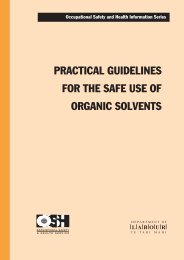
![Task analysis worksheet [161 KB PDF] - Business.govt.nz](https://img.yumpu.com/51400981/1/190x135/task-analysis-worksheet-161-kb-pdf-businessgovtnz.jpg?quality=85)

